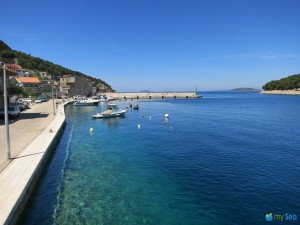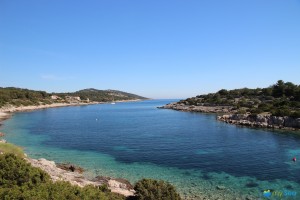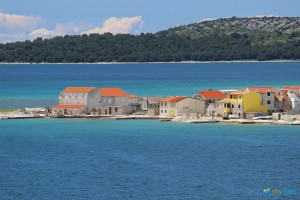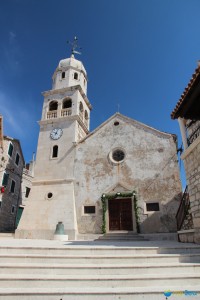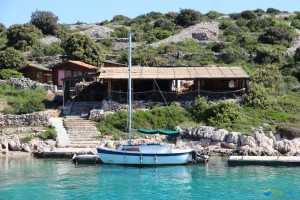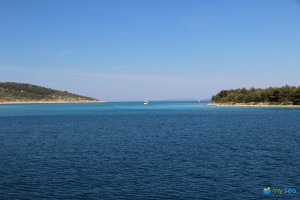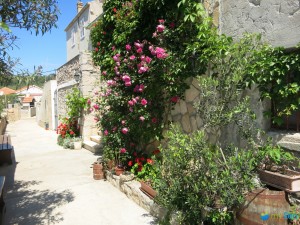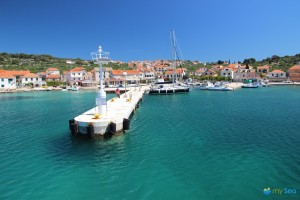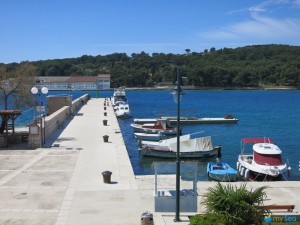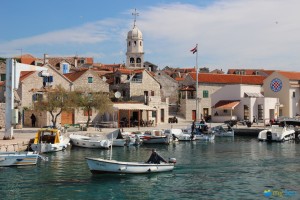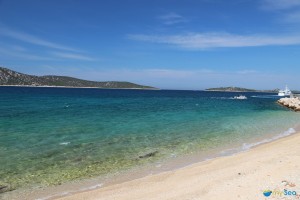Bitte bei mySea einloggen um den Links zu folgen!
Kurz drauf werfen wir die Leinen los, um schon bald Muna auf Žirje zu erreichen. Muna ist eine kleine Siedlung, in der die Zeit stehengeblieben zu sein scheint. Der Ort ist noch weniger überlaufen und touristisch erschlossen als andere Orte im Archipel von Šibenik. Auch in der Saison wirkt er so, als befände er sich noch im Winterschlaf. Seit Frühjahr 2014 hat sich jedoch die Liegeplatzsituation deutlich verbessert. Es stehen nun 20 Liegeplätze mit Muringleinen am östlichen Kai zur Verfügung. Die Tiefe am Kai beträgt ca. 2 bis 3 Meter. Der Platz direkt am Wellenbrecher ist für die Fähre, die Lebensader der Insel, freizuhalten. Im Hafen gibt es einen kleinen Minimarkt sowie ein Restaurant und ein Café, die von ca. Juni bis Mitte September geöffnet haben. Strom, Wasser oder Sanitäranlagen sind nicht vorhanden.
Ante steht bereits am Kai und ist uns beim Anlegen behilflich. Sein alter Suzuki Geländewagen knarrt und ächzt als wir über die unebenen Schotterwege fahren. Žirje ist die größte Insel des Šibeniker Archipels und am weitesten von der Küste entfernt. Die Tourismusströme laufen größtenteils an der Insel vorbei. Hauptsächlich sind hier Individualtouristen wie Wanderer, Mountainbiker und natürlich Segler anzutreffen. Alles was die 80 verbliebenen Einwohner und Touristen brauchen, wird entweder selber angebaut oder muss mit der Fähre vom Festland rüber transportiert werden. Im Winter ist das Leben auf der Insel sehr einsam und manchmal beschwerlich.
Die Koromasna Bucht im Osten der Insel steht nur bei wenigen Crews auf dem Törnplan. Einige unfertige Häuser verunstalten das ansonsten grüne Ufer. Einige Fischerkähne liegen hinter einer Mole. An ruhigen Tagen ist das Wasser so klar, dass es schwierig ist die Wasseroberfläche vom Grund zu unterscheiden. Im südöstlichen Teil der Bucht hat in der Saison ein Restaurant geöffnet. Davor gibt es einen kleinen Kai, dessen Tiefe aber nicht überall für Yachten geeignet ist.
Die Südostküste ist stark zergliedert und bietet für Yachten einige Highlights in Form der Buchten Mala und Vela Stupica. In der weiter östlich gelegenen, kleineren Bucht ankert man frei inmitten einer herrlich unberührten Natur. Keine vorgelagerten Inseln behindern mehr den freien Blick auf die weite Adria. Gäbe es die Erdkrümmung nicht, würde man von hier aus auf den italienischen Stiefel schauen. In der Vela Stupica gibt es zwei große Bojenfelder mit zusammen knapp 40 Bojen. Durch den hellen, sandigen Grund wirkt das Wasser noch klarer als es ohnehin schon ist. Am Ufer „versteckt“ sich zwischen Schatten spendenden Pinien die urige Konoba Stupica. „Ohne Reservierung geht in der Saison gar nichts“ sagt Maria, die Konobachefin. In dem liebevoll gepflegten Gelände gibt es nur wenige Tische, Massenspeisung gibt es hier nicht. Ohnehin kommen nur Fisch und Fleisch auf den Tisch sowie Gemüse von der Insel. Eben das, was gerade verfügbar ist.
Viele Besucher bleiben gleich einige Tage in der Bucht, um die Ruhe zu genießen. Wer Bewegung sucht, dem sei ein Spaziergang auf den Berg Gradina empfohlen. Hier sieht man noch Überreste einer Byzantinischen Festung aus dem 6. Jhd. Spektakulär ist auch der Ausblick. Für den Weg empfiehlt sich festes Schuhwerk. Ante kennt natürlich alle Wege auf der Insel. Er greift sich einen Stock und wedelt die ganze Zeit damit vor sich her. Zwischen den Büschen haben Spinnen Ihre Netze gespannt und warten geduldig auf Beute. Mit dem Stock verschafft uns Ante freie Bahn und sorgt dafür, dass wir nicht zur Beute der Krabbeltiere werden.
Auf der Westseite Žirjes liegt die weit einschneidende Tratinska Bucht, die hervorragenden Schutz vor der Bora bietet. Je tiefer man in die Bucht reinfährt, desto besser ist auch der Schutz. 22 Bojen sind in der Saison ausgelegt. Am Nordufer liegt die Tratinska Konoba, die von einem jungen Paar geleitet wird. Zur Konoba gehören auch einige Apartments mit Swimmingpool. Ebenfalls sind hier ein Stützpunkt des Yachtsportverbands Österreich (YSVÖ) und eine Tauchbasis beheimatet.
Ante verspricht uns noch ein ganz besonderes Highlight. Da unsere Zeit begrenzt ist steigen wir wieder in den klapprigen Suzuki. Der Weg führt an der Tratinska Bucht vorbei immer den Berg hinauf. Früher hat die jugoslawische Armee auf dem Bergkamm einen Beobachtungsposten betrieben. Schnell wird auch klar warum. Es gibt in der Gegend keine zweite Stelle, von der aus man einen besseren Rundumblick hätte als von hier oben. Nach Norden zeigen sich die versprengten Inseln der Kornaten, nach Osten übersieht man den gesamten Šibenik Archipel, Murter und Šibenik Stadt. Nach Süden hin tauchen die Umrisse von Vis auf, und an klaren Tagen kann man in Richtung Westen bis nach Italien sehen. Umrahmt von einem Geländer dient ein alter Betonbunker als Aussichtsplattform. Auf dem Geländer sind kleine Schilder angebracht, die Name und Entfernung der jeweiligen Orte zeigen. Richtung Südosten entdecken wir ein Schild dessen Ort wir nicht sehen können: in 13.109 km Entfernung liegt Perth, Australien.
Auf dem Rückweg statten wir Krapanj, der am dichtesten besiedelten Insel Kroatiens noch einen Besuch ab. Die Insel liegt gerade einmal 1,5 Meter über dem Meeresspiegel und ist vom gegenüberliegenden Festlandort Brodarica nur 300 Meter entfernt. Die Zufahrt ist nur von Süden kommend möglich, denn im Norden der Insel ist es sehr flach. Krapanj ist ein beliebtes Fotomotiv. Passiert man hinter Brodarica die Brücke, gelangt man auf einen kleinen Parkplatz von wo aus man einen unverbauten Blick auf Krapanj hat. Im Sonnenlicht scheint es, als ob die Häuser und das umgebende Meer leuchten würden. Ein malerischer Anblick.
Der Hafen ist nur für einheimische Yachten, für Gäste ist hier kein Platz. Die sind jedoch an der gut ausgebauten Steganlage mit Muringplätzen, Strom und Wasser des Hotels Spongiola gerne gesehen. Direkt daneben liegt ein kleiner Strand. Sanitäranlagen stehen im Hotel zur Verfügung. Auf der gegenüberliegenden Festlandseite hat das bekannte Restaurant Zlatnaribica einen Steg ausgebracht, an dem man nur anlegen darf, wenn man auch ins Restaurant zum Essen geht. Das Restaurant ist vor allem wegen des frischen Wildfischs und der Meeresfrüchte berühmt. Dafür gab es schon diverse Auszeichnungen und Preise.
Wir haben noch viele weitere Buchten, Ankerplätze, kleine Anleger, Restaurants und nette Menschen auf unserer Entdeckungstour durch den Archipel von Šibenik getroffen. Die Menschen in der Region machen alle einen entspannten Eindruck, es geht weniger hektisch zu als in anderen Orten. Und das ist wohl auch das Geheimnis der Region. Die Region ist etwas für Naturliebhaber und Menschen, denen genussvolles Leben wichtiger ist als das Schnelllebige. Wer die Region noch nicht kennt, sollte ein wenig Zeit mitbringen, um die schönsten Ecken zu erkunden. Šibenik ist der ideale Ausgangpunkt dafür.
Das Archipel von Sibenik ist auch für Yacht Charter Segler bestens geeignet. In der D-Marin Sibenik (Marina Mandalina) bietet neben NCP und Mare auch der Österreichische Vercharterer Yachting 2000 gepflegte Yachten an. Auch Yachting 2000 lässt sich von seinen Kunden während des check outs bewerten. Diese echten Erfahrungen von Yachtcharter Kunden über Yachting 2000 finden Sie auf Euminia – dem führenden Bewertungssystem für Charteryachten.
Haben Sie schon Teil & 1 & 2 gelesen?
Mehr Infos dazu findest du auf mySea.
